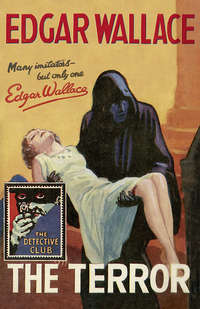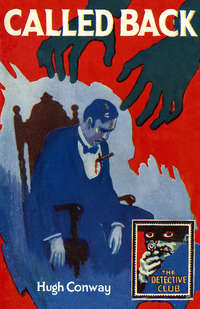
Полная версия
The Golden Age of Murder
Arthur Conan Doyle died on 7 July 1930, and Sayers spotted an opportunity to promote the new Club. Shamelessly, she told Berkeley: ‘Old Conan Doyle chose this moment to pop off the books. I just put on a card ‘To the creator of ‘Sherlock Holmes’ from the members of the Detective [sic] Club with reveration [sic] and deep regret.’ I thought it would look well and be a bit of publicity.’
In January 1931, Berkeley suggested that Club members might put together a ‘Detection Annual’, modelled on the popular, though sporadically published, Printer’s Pie. Baroness Orczy was among those willing to contribute, but before long, this proposal was superseded by the concept of a full-length Detection Club novel, and the result was The Floating Admiral.
At the same time, Christie contemplated writing a novel set around a ‘Detective Story Club’ involving ‘13 at Dinner’. In one of her private notebooks, she listed the cast of characters. Sayers and her husband are included, alongside a mention of ‘Poisons’, as are Freeman Wills Crofts and his wife (‘Alibis’), Christie herself, John Rhode, Edmund Bentley, Douglas and Margaret Cole, and Clemence Dane. Anthony Berkeley (and his wife, which suggests the couple contrived to keep their matrimonial difficulties to themselves) also appeared on the list.
Christie adds the note ‘fantastic writer’ next to Berkeley’s name. The admiration they had for each other’s skill and originality with mystery plots was genuine and deeply felt. Perhaps because she feared she could not out-do The Poisoned Chocolates Case, Christie never pursued the story idea. The sinister implications of an unlucky number of dinner guests were, however, soon realized in Lord Edgware Dies, the American title of which was Thirteen at Dinner. The other writer named on the list in her journal was the American S. S. Van Dine. This was odd, since Van Dine was never a member of the Detection Club. He had, however, visited England not long before, and may have been invited to one of Berkeley’s dinners as a guest. In later years, Christie jotted down an idea about her character Ariadne Oliver, a scatty detective novelist, attending a Detection Club dinner with guests. Murder was to take place when the Club’s initiation ritual began. It is a shame that she never developed this appealing idea.
On 1 May 1931, Berkeley wrote to tell Chesterton that a new member, Helen Simpson, was to be initiated in a ‘ceremonious ritual’ devised by Sayers. He thought the idea of giving solemn pledges to honour the values of fine detective writing would be amusing. This is the first recorded mention of the Detection Club’s initiation ritual.
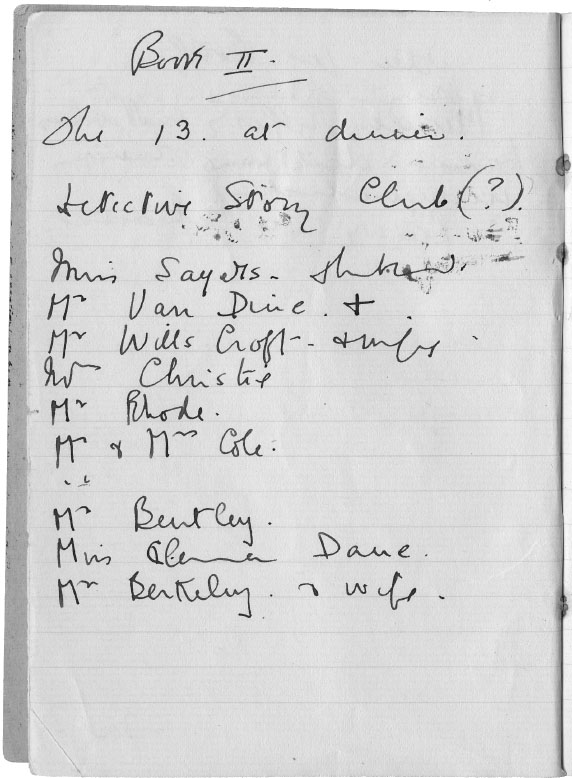
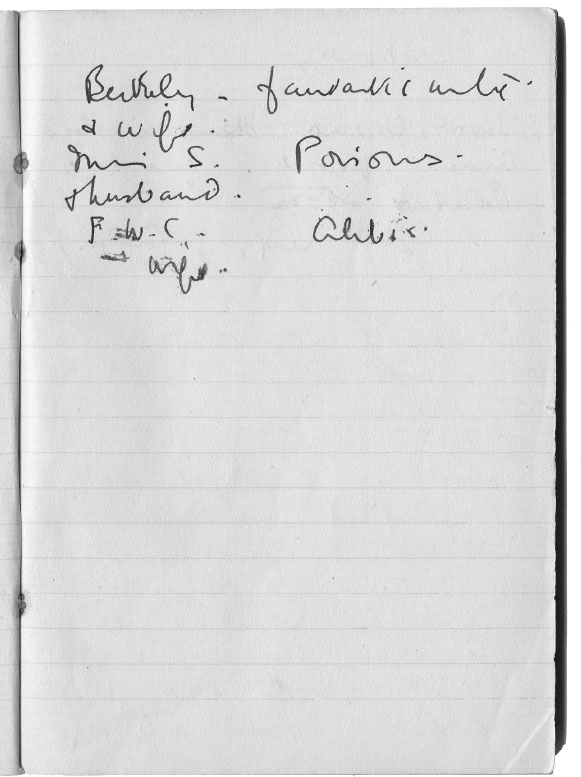
Agatha Christie’s notebook 41: extract featuring a story idea based on the Detection Club (by permission of the Christie Archive Trust).
Club members took a strikingly modern approach to combining self-promotion with supporting a good cause, and four members collaborated in a fundraising event for a hospital charity on 31 May 1932. Berkeley (described in the publicity as the Club Secretary), Bentley, Crofts and Margaret Cole were subjected to a ‘mock trial’ at the London School of Economics, charged with ‘faking the evidence’ by a prosecuting barrister, with a King’s Counsel sitting in judgment.
Less than three months earlier, on 11 March, the Rules and Constitution of the Club had been adopted. They stated that the Club was instituted ‘for the association of writers of detective novels and for promoting and continuing a mutual fellowship between them.’ To promote the Club’s aims, the suitability of every candidate for membership was to be ‘fully and carefully examined’ to ensure that he or she had written ‘at least two detective novels of admitted merit or (in exceptional cases) one such novel; it being understood that the term ‘detective novel’ does not include adventure stories or “thrillers” or stories in which the detection is not the main interest, and that it is a demerit in a detective novel if the author does not “play fair” with the reader.’
Why exclude thriller writers? Christie and many other members wrote thrillers from time to time, and even Sayers had contemplated adding to the mountain of stories about Sexton Blake. The answer was that Sayers and her friends had no time for crude blood-and-thunder merchants. However, the rule did mean that Bentley’s old friend John Buchan, a pillar of the establishment and by a distance the most distinguished British thriller writer, was ineligible for membership, since none of his books could be classed as a detective novel.
In total there were twenty-three rules. They provided that a member who was guilty of a deliberate breach of the rules or damaged the Club’s interests was liable to expulsion. Nobody has ever been expelled, which shows the value of a rigorous approach to recruitment. By the time the Rules and Constitution came into force, there were twenty-eight members. The rules make no provision for ‘Associate Members’, yet Hugh Walpole and Helen Simpson have been described as such in the Club’s list of members. In the list for 1939–40, Walpole is described as an ‘Honorary Member’, as is Sir Norman Kendal, who was not a writer at all, and there is no suggestion that Simpson was not a full member. Presumably this untidiness is due to doubt as to whether Walpole’s psychological thrillers qualified as ‘detective novels’, despite his participation in the Behind the Screen project. Simpson was eminently qualified for full membership, whereas Kendal’s election was a goodwill gesture. One mystery is why the name of R. C. Woodthorpe, elected in 1935, has not appeared in the list of members for the last half-century. Was he thrown out, and his name expunged from the records, for some unspeakable transgression? The likeliest solution is that the omission of his name was a simple mistake.
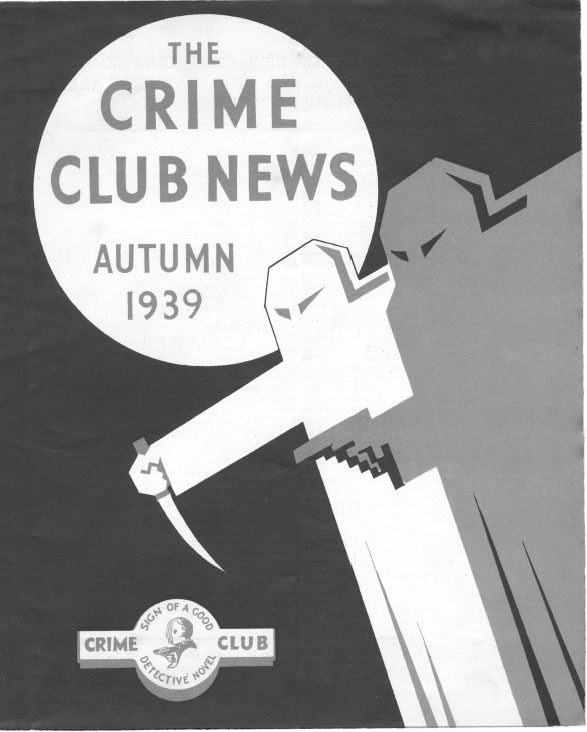
The cover of Collins’ Crime Club newsletter for autumn 1939.
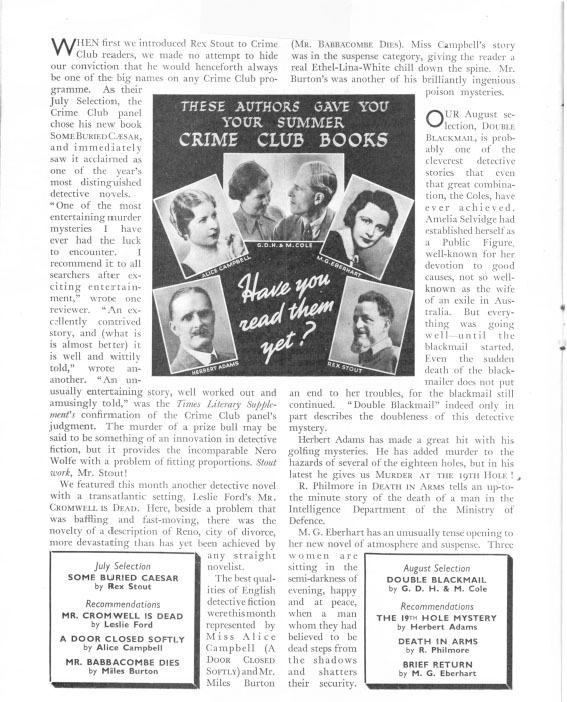
Two sample pages from Collins’ Crime Club newsletter.
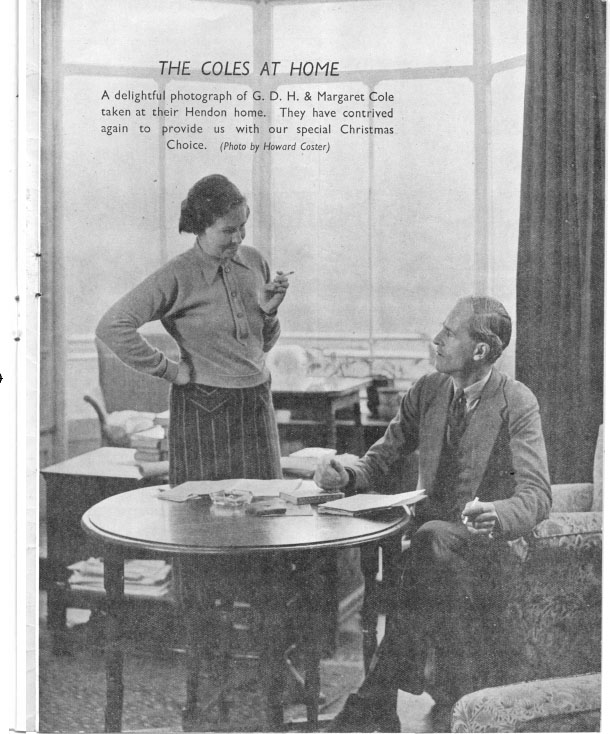
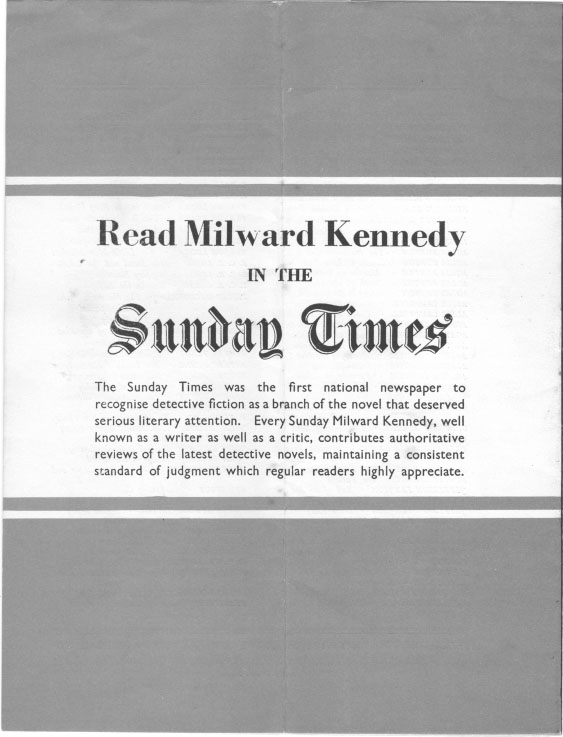
The Crime Club News’ back page advertisement for Milward Kennedy’s reviews in the Sunday Times.
Despite the veneer of formality, nobody cared about inconsistencies of detail, as long as the Club’s core values were preserved. When creative people get together, sparks often fly, and that happened from time to time in the Detection Club. It was rare, though, for members to risk damage to their relationships through backbiting. They were excited by the prospect of exploiting the potential of the detective story. The mix of strong personalities and varied talents was a source of strength. Berkeley had the vision, Chesterton supplied gravitas, and Sayers led by energetic example. Her study of the history of detective fiction broke new ground, paying tribute to the contribution to the genre made by older members of the Club, and signalling how the modern writers could take it to fresh heights. Like any good detective, she knew that to understand the present, and what the future may hold, one needs to understand the past.
Notes to Chapter 6
The first person who set out to solve ‘the riddle of the Detection Club’ was Clair Price
See Clair Price, ‘A New Code for Crime between Covers’, New York Times, 24 July 1932.
Julian Symons, a historian as well as a crime writer of distinction and former Club President, mistakenly wrote that the Club started in 1932.
Symons said this in his introduction to Verdict of 13: A Detection Club Anthology (London, Faber, 1979), where he also expressed the belief that John Dickson Carr was ‘the only member ever elected who was not British’. A more reliable account of the Club’s early days was supplied by John Rhode’s Foreword to an earlier Club anthology, Detection Medley.
In other respects, Mary Fitt … was as reticent as Berkeley
Even so, she was persuaded by Picture Post to be photographed on her hands and knees, peering through a magnifying glass at a Greek vase.
The novel was an expansion of ‘The Avenging Chance’
Curiously, the story appears to have been published after the novel. A latter-day Berkeley might come up with multiple explanations for this little mystery. Perhaps he realized the strength of his short story’s plot, and delayed its publication until he had exploited it more fully, and more lucratively, through the novel.
On 27 December 1929, Berkeley wrote to G. K. Chesterton
No original correspondence relating to the early days of the Detection Club remains in the Club’s possession; while the Minute Book has apparently not been seen since the Second World War. The Club’s archive is, at the time of writing, in the process of development. I have gleaned information about the correspondence mentioned in this book from a wide variety of sources, in particular the Marion E. Wade Center at Wheaton, from Arthur Robinson, Tony Medawar, George Locke, Douglas G. Greene and Curtis Evans, as well as from occasional sales of material on www.abebooks.com.
‘Plotting a Detective Story’
See Tony Medawar, ‘Plotting a Detective Story – Dorothy L. Sayers and Anthony Berkeley’, CADS 51, April 2007.
four members collaborated in a fundraising event for a hospital charity on 31 May 1932
A fifth collaborator was Captain Alan Thomas (1896–1969). His The Death of Laurence Vining (1928) was a well-regarded ‘impossible crime’ novel, and he later became editor of The Listener. Death of the Home Secretary (1932) is one of a host of Golden Age mysteries in which politicians meet an untimely end.
7
The Art of Self-Tormenting
‘The art of self-tormenting is an ancient one,’ Sayers proclaimed in her essay introducing the first volume of Great Short Stories of Detection, Mystery and Horror. She knew more than most people about self-torment. Keeping her son’s existence secret was a constant strain, and on one occasion before she married Mac her self-discipline snapped. She confided in a total stranger, a woman with a boy of ten who had just divorced her husband, and who envied Sayers because nobody else was laying claim to her son. Sayers told John Cournos that contemplating someone else’s misfortune made her feel better, but she still wanted to find a man ‘to help me to handle the kid later on’. Mac never offered such help.
The self-torment she was talking about was the way that people love to be teased by a mystery. To trace the roots of detective fiction, she delved into ancient texts like a gumshoe determined to leave no stone unturned. Her hunt for early forerunners of the detective story yielded some unlikely suspects. Analysis of evidence featured in the Apocrypha, the fabrication of false clues appeared in Herodotus, and psychological detection underpinned the story of Rhampsinitus. Sayers was stretching to prove her point, but not as far as it might seem. Nine years after her anthology appeared, the murderer in John Dickson Carr’s To Wake the Dead relied on an intricate scheme echoing the story of Rhampsinitus.
Why had detective fiction not developed sooner? The Jews, ‘with their strongly moral preoccupation’ were, Sayers felt, well suited to create detective stories. So were the Romans, with their taste for logic and law-making. She identified elements of detection in one of the Grimms’ tales, and in an Indian folk-tale. Yet although stories about crime had flourished for centuries, the detective story could not thrive until the wider public sympathized more with the forces of law and order than the law-breakers.
Sayers argued that the ground rules for the genre were set forever in the United States, in the 1840s, when Edgar Allan Poe wrote five seminal tales of mystery and imagination. First came ‘The Murders in the Rue Morgue’, a ‘locked room’ story. A woman and her daughter are found savagely murdered inside a locked room. The central puzzle, borrowed by hundreds of Poe’s successors was – how could the murderer have got in and out?
Poe created a gifted and eccentric amateur sleuth, Chevalier C. Auguste Dupin, the first of fiction’s Great Detectives. Dupin’s cases were told by an unnamed chronicler, setting the template for Holmes and Watson, Poirot and Hastings, and dozens of less celebrated pairings, in which admiring sidekicks ranging from the obtuse to the sophisticated recount the exploits of amateur sleuths who almost always outsmart the professional police. The neat twist in ‘The Purloined Letter’ was that the solution was so obvious that everyone overlooked it. Chesterton’s ‘The Invisible Man’ was the most famous of many later stories using this trick of a clue hidden in plain sight. Even more influential was ‘The Mystery of Marie Roget’, in which Dupin plays the ‘armchair detective’. This was the very first detective story based on a criminal puzzle from real life.
Marie Roget was the fictional counterpart of Mary Rogers. She worked in a New York tobacconist’s, and her ‘raven tresses’, womanly figure and tantalising smile inspired young male customers to poetry and earned her the sobriquet ‘the beautiful cigar girl’. Among Mary’s admirers was a young lawyer called Alfred Crommelin. She rejected his advances, and became engaged to Daniel Payne, a cork cutter. Subsequently, she left a note at Crommelin’s apartment, hinting at a reconciliation. When he did not reply, she sent him a series of letters, and asked for money. Shortly afterwards, on 23 July 1841, she disappeared. This was not the first time she had vanished without explanation; the same thing had happened three years earlier.
A few days after she went missing, a group of young men decided to escape the steamy heat of the city by walking out to Sybil’s Cave at Hoboken. They noticed clothes floating in the shallow waters of the North River, and thought someone had fallen in. Finding a wooden scull nearby, they rowed over to the bobbing objects, to discover the body of a young woman, whose long black hair rippled in the water like seaweed. A slip of cloth was knotted around her neck. One report said, ‘Her forehead and face appeared to have been battered and butchered, to a mummy.’
The remains were identified as Mary’s. A popular theory was that she had been killed by a gang, although Payne and Crommelin also came under the microscope. The plot thickened when some of her garments were found close to a tavern run by a Mrs Frederica Loss. Daniel Payne committed suicide, and Frederica Loss was shot by one of her sons, but the precise details of Mary Rogers’ death were never established. Mrs Loss supplemented her income with work as an abortionist, and Mary’s death probably followed a termination that went wrong.
Poe hinted at the truth in his story (transplanted to Dupin’s home turf in Paris) as well as offering a more imaginative alternative theory. Sayers was impressed by his efforts at solving a real-life mystery, and by Arthur Conan Doyle’s ‘splendid efforts’ on behalf of George Edalji and Oscar Slater, wrongly accused men who benefited from his work as an amateur detective. Detection Club members were keen to follow the lead given by Poe and Conan Doyle – none more so than Sayers herself.
Poe showed how to transform a real-life case into detective fiction, and a generation later Wilkie Collins followed his example in The Moonstone. He borrowed details from the Constance Kent case, and based Inspector Cuff on the real-life Inspector Whicher. For Sayers, The Moonstone came closer to perfection than any other detective story, even though Arthur Conan Doyle’s Sherlock Holmes was incontestably the greatest detective. Collins was the most gifted author of Victorian ‘sensation novels’, but the short story remained the dominant form in detective fiction until the Golden Age.
Sayers loved the Holmes tales, and admired the way Conan Doyle enriched English literature with countless memorable lines. There is a striking resemblance between lines from ‘The Musgrave Ritual’ and a passage in Eliot’s Murder in the Cathedral, while the success of Mark Haddon’s novel The Curious Incident of the Dog in the Night-Time and the television show Sherlock demonstrate that Holmes-speak still appeals in the twenty-first century.
Sherlock Holmes’ leading rivals were created by three contrasting writers – a socially mobile Cockney, a rural dean, and a Hungarian baroness – who would become Detection Club members. Arthur Morrison, son of an engine fitter, exploited his literary gifts to escape London’s slums. A journalist, he hit his stride with Tales of the Mean Streets¸ but could scarcely have guessed that ‘mean streets’ would become a phrase associated with American private eyes. Morrison depicted the East End with an insider’s expertise, but became embarrassed by his humble origins. He even falsified data on the national census to conceal his date and place of birth. It is a pity he was so sensitive, since the strength of his writing lies in an understanding of working class life that Berkeley, Sayers and Christie could never match.
Morrison’s Martin Hewitt, a lawyer turned private investigator, was meant to fill the gap left by Holmes’ plunge into the Reichenbach Falls. Portly and good-natured, Hewitt was too ordinary to outshine the sage of 221b Baker Street, dead or alive. More distinctive was Horace Dorrington, a suave villain who plans a murder at the start of The Dorrington Deed-Box. His scheme fails, and although he escapes justice, his intended victim discovers the records of several cases in which Dorrington combines work as a private inquiry agent with shameless criminality. Morrison abandoned Dorrington after one book, but had created the literary ancestor of the murderous charmer Tom Ripley, created by Patricia Highsmith, herself a member of the Detection Club, and of Jeff Lindsay’s serial killer Dexter Morgan.
Thorpe Hazell was another eccentric Great Detective. Hazell is a specialist railway detective, a vegetarian and health fanatic. After solving the puzzle of ‘Sir Gilbert Murrell’s Picture’, he declines Sir Gilbert’s offer of a cooked lunch. He has already ordered lentils and salad to eat at a railway station, and starts to perform his ‘physical training ante-luncheon exercises’. As the bewildered baronet watches him ‘whirling his arms like a windmill’, Hazell explains, ‘Digestion should be considered before
Конец ознакомительного фрагмента.
Текст предоставлен ООО «ЛитРес».
Прочитайте эту книгу целиком, купив полную легальную версию на ЛитРес.
Безопасно оплатить книгу можно банковской картой Visa, MasterCard, Maestro, со счета мобильного телефона, с платежного терминала, в салоне МТС или Связной, через PayPal, WebMoney, Яндекс.Деньги, QIWI Кошелек, бонусными картами или другим удобным Вам способом.


